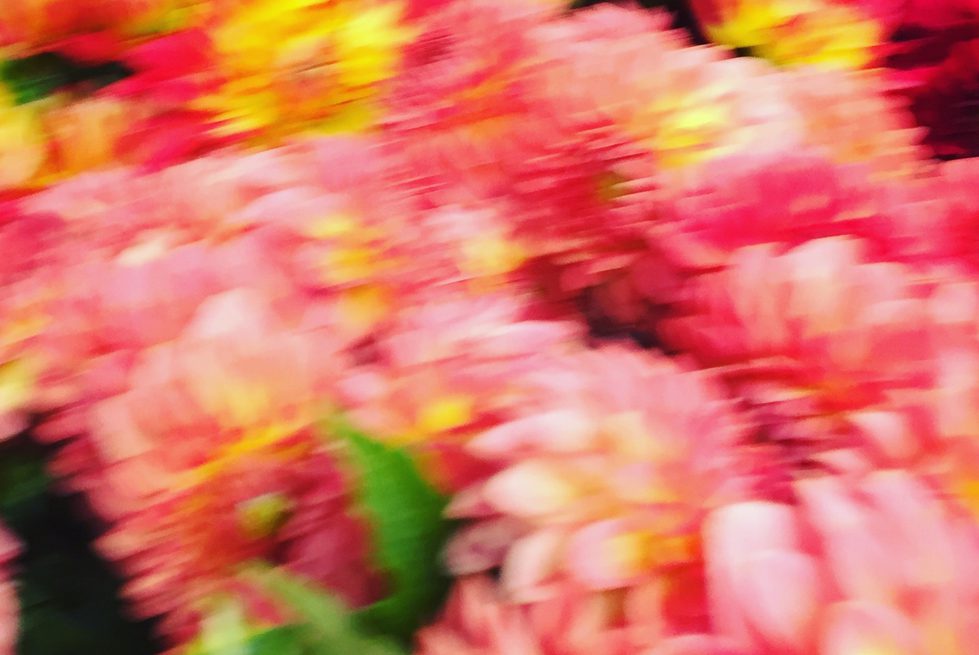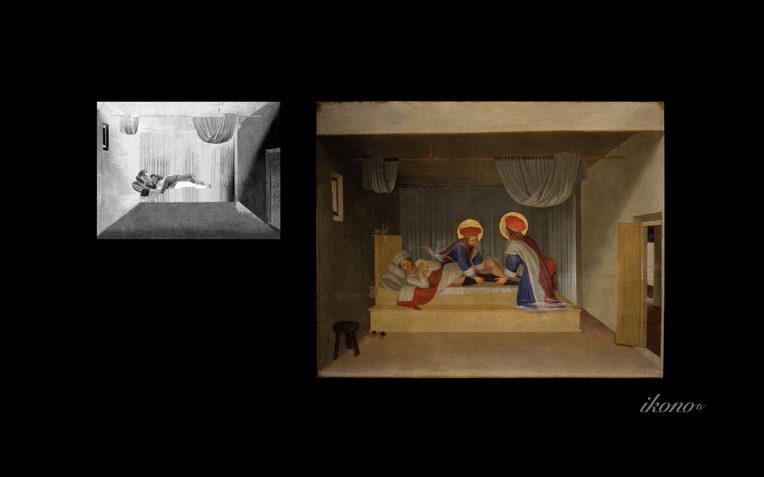Cogitation
From the Series: Images
From the Series: Images

I am looking at Blinding Light, part of an ongoing photographic series by contemporary artist Mounir Fatmi, initiated in 2011 as a video enigmatically titled The Angel’s Black Leg. The image-work is bewildering: a photomontage that superimposes scenes of surgery from the early Renaissance and the present day, taking cues from Fra Angelico’s painting The Healing of Justinian by Saint Cosmas and Saint Damian.


I first saw The Healing of Justinian at the Museum of San Marco in Florence, where it is placed on the right side of the altar. Like Fatmi, I too am fascinated by Fra Angelico. Fatmi, who studied art in Rome, has been particularly outspoken about his obsessive relationship with this painting. Artists are often each other’s eternal returns, their art practice guided by a desire to catch a glimpse of a shared intensity released from epochal thinking, yearning for salutary modes of simultaneity. No exception here. Fra Angelico and Fatmi are contemporaries, prompting the latter to de- and reassemble elements from the former’s painting by observing—in both senses of inquiry and belief—Fra Angelico’s characteristically spare mise-en-scènes. In this series, a multimedia operation is taking place, mirroring the surgical scene of the original painting. With the aid of optical and medical instruments—X-rays, magnifying glasses, and mirrors—the photomontage meticulously reproduces, scans, and diagnoses the iconic painting. Through various editing techniques we encounter anew the fresco’s scene and the story it is recounting: Justinian, a Tuscan religious figure, sleeps while Saints Cosmas and Damian prepare to amputate his diseased leg and replace it with a healthy one.
Scholars have speculated that both physicians in the painting, Cosmas and Damian, were Christian converts of Arab descent. Moreover, Fatmi’s photographic intervention assigns much importance to the blackness of the leg used as prosthetic, a leg believed to have belonged to a recently deceased Ethiopian man. Cognizant of the artifice underwriting both narrative and plastic registers of the leg, Fatmi reconfigures it by creating “three prints in the series (and one on a mirrored surface), each doctored differently” (Weeks 2013). These are organized contrapuntally, as images that reverse and multiply the polarity of black and white. In one of them, the human figure has a white body and a black leg. In another, it has a black body and a white leg. The word healing in Fra Angelico’s title marks the fragile health and precarious future of the human figure lying on the operating table, halfway between life and death. Fatmi’s title, Blinding Light, reinforces the relationship of mutual intrusion between painting, medicine, and photography. It marks the kind of luminous excess experienced by patients in operating rooms, or the kind of excess felt in the absence of optical devices, like UV glasses worn when one looks directly into the sun during an eclipse. Anthropologists are accustomed to working with available light. Fatmi requires us to overexpose the Enlightenment.
Fatmi’s remediation of Fra Angelico’s miraculous scene hinges not on equivalence, nor similitude, nor a cross-cultural exchange of glances (see Belting 2012). It is also unclear whether Fatmi’s reliance on photography is motivated by evidentiary, indexical, or analogical interests. This speaks to a measure of “creative indeterminacy,” as Anand Pandian puts it, and of an entirely “different problem of evidence,” as Todd Meyers does. By inserting a present-day surgical scene into Fra Angelico’s depiction of pious healing, the artist is playfully creating resonances between the personae of surgeon, art expert, and curator. Moreover, Fra Angelico’s use of pastels, soft chromatic palette, and sober minimalism are reanimated with striking force. The stillness evoked by the painting’s modestly furnished room lives on as well: a short stool; a pair of slippers; curtains; a jug; a bed; a patient on a bed; a small window on the left allowing light in; and a door on the right, opening onto a hallway that also serves as a light source, creating a slight perspectival effect. All we can do, as spectators, is abandon ourselves into a space somewhere between copy and original, between X-rays and visible light. What, who, and where, we might ask, is the “mysterious kind of intentionality” (Silverman 2015, 7) that reveals this composite of photographic and painterly tableau-vivant?
Fatmi’s image-work—its mirror-effects, the artifice of its intentio, the punctum of the sutured black leg—takes place in “an intermediary space between bodies and souls” (Coccia 2016, 19). His art reveals a “fissure through which crowds of images aspiring to birth may be introduced in some indefinite realm—a realm which is neither that of physical extent nor that of pure thought” (Focillon 1989, 35). For Fatmi, Fra Angelico’s painting is a realm composed of an infinite number of healing scenes. His photomontage “consists in rendering present all the different kind of images of the imagined possibilities concerning the thing on which he is cogitating” (Marks 2010, 63). We too move from imagination towards cogitation.
Of the three faculties that make up the intermediary zone between the sensible and the intelligible (imagination, cogitation, and memory), twelfth-century Andalusian rationalist philosopher Averroes praised cogitation, an activity that included a wide range of states: contemplation, daydreaming, study, meditation, intellectual struggle, and more. Under the influence of the intellect agens, the cogitative faculty serves as “an interface that acts on images in two different ways: either by division, extracting from images their m’ana, their intentio; or it acts on images by composition, by combining intentio and image” (Brenet 2017, 32–33; author’s translation). Photographic cogitation—from camera obscura to digital rendering—releases the image from embodied sensorial channels, draws from and yet exceeds our imagination, preparing us for conceptual illumination by an extracorporeal and inorganic intelligence. Fatmi replays what one scholar calls Averroes’s “painful and extraordinary modernity” (de Libéra 1998; author’s translation) insofar as cogitation is the power that both produces images of thought and animates a thought without images. This virtus cogitativa is, I think, anthropology’s mysterious gift and a potential answer to Lisa Stevenson’s question.
Belting, Hans. 2012. Florence and Baghdad: Renaissance Art and Arab Science.Translated by Deborah Lucas Schneider. Cambridge, Mass.: Harvard University Press. Originally published in 2008.
Brenet, Jean-Baptiste. 2017. Je fantasme: Averroes et l’espace potentiel. Paris: Verdier.
Coccia, Emanuele. 2016. Sensible Life: A Micro-Ontology of the Image. Translated by Scott Alan Stuart. New York: Fordham University Press.
de Libéra, Alain. 1998. “Averroes: douloureuse et extraordinaire modernité d’Averroès.” Confluences Mediterranee, no. 28: 15–24.
Focillon, Henri. 1989. The Life of Forms in Art. Translated by Charles B. Hogan and George Kubler. New York: Zone Books. Originally published in 1934.
Marks, Laura U. 2010. Enfoldment and Infinity: An Islamic Genealogy of New Media Art. Cambridge, Mass.: MIT Press.
Silverman, Kaja. 2015. The Miracle of Analogy, or, The History of Photography: Part 1. Stanford, Calif.: Stanford University Press.